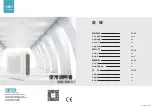
Response by Control Type—Advanced Microprocessor Controls
37
Suggested System Tuning Procedure
1. Initially adjust the integral and derivative settings to 0%/degree-min and 0%/degree/min.
2. Starting with 20% /degree, adjust the proportional setting in small increments (10% steps) until
the control sustains a constant hunting action (the temperature swings are approximately the
same amplitude from one peak to the next).
3. Note the time in minutes between peaks of adjacent temperature swings and the amplitude of the
temperature swing (degrees above the setpoint).
4. Adjust the Proportional Control setting to about 1/2 the value obtained in step 2.
5. Adjust the integral setting to a value calculated by the following equation:
6. Adjust the derivative to a value calculated by the following equation:
time between peaks x 5%
The above tuning procedure is only an approximation for an initial set of adjustments and are based
on the “average” room characteristics. Your particular settings may need to be further adjusted for
optimum PID Control performance. Some suggestions for additional tuning are:
• If cooling output overshoot is occurring on load changes, decrease the proportional setting or the
derivative setting.
• If system hunting occurs with constant room load, decrease the integral setting.
• If the control responds too slowly, resulting in large temperature excursions on a load change,
increase the proportional setting or the derivative setting.
• If a constant temperature deviation exists between the temperature and setpoint, increase the
integral setting.
NOTE
If this calculation results in a value of less than 1%, set the integral to 1%.
approximate room load (in % full load)
time between peaks x peak amplitude x 4
















































